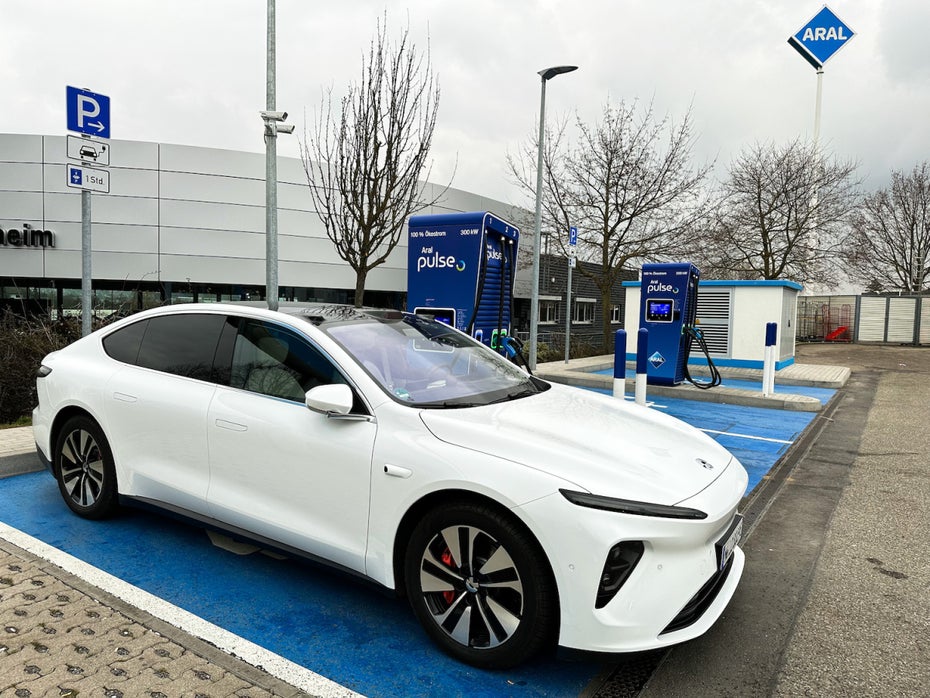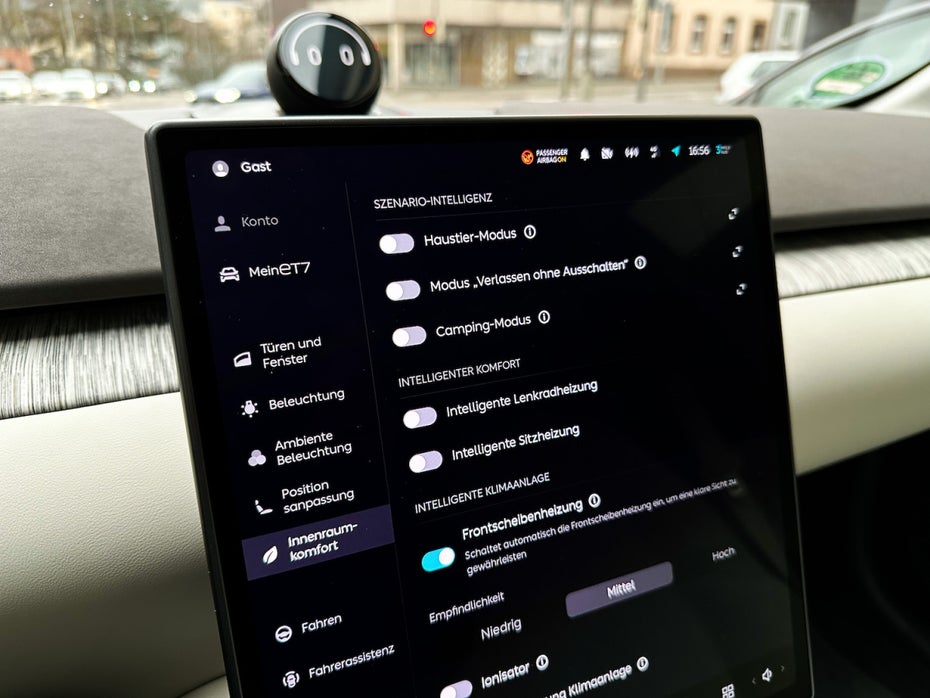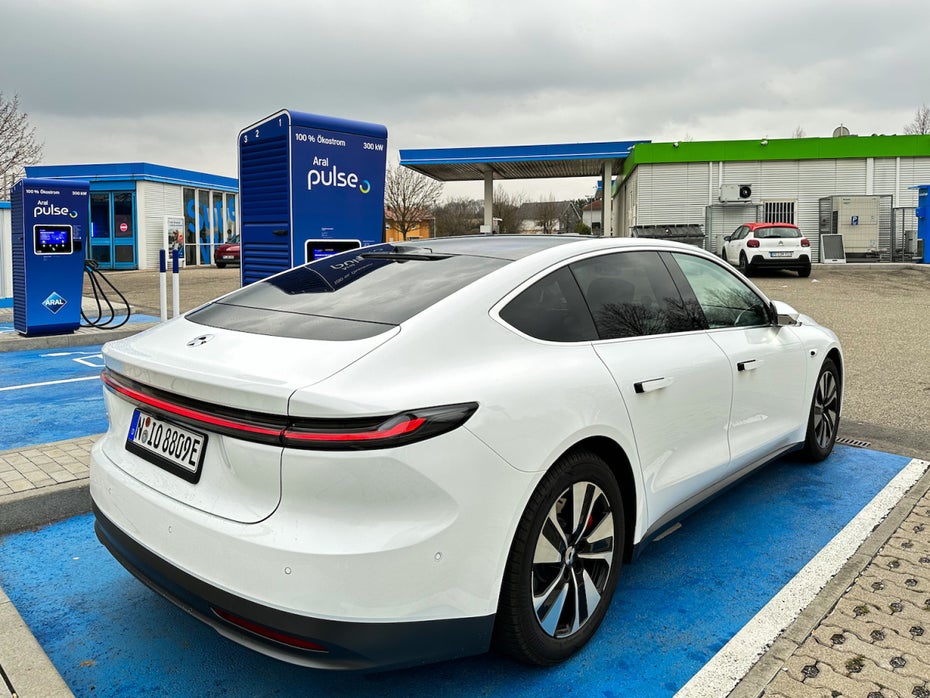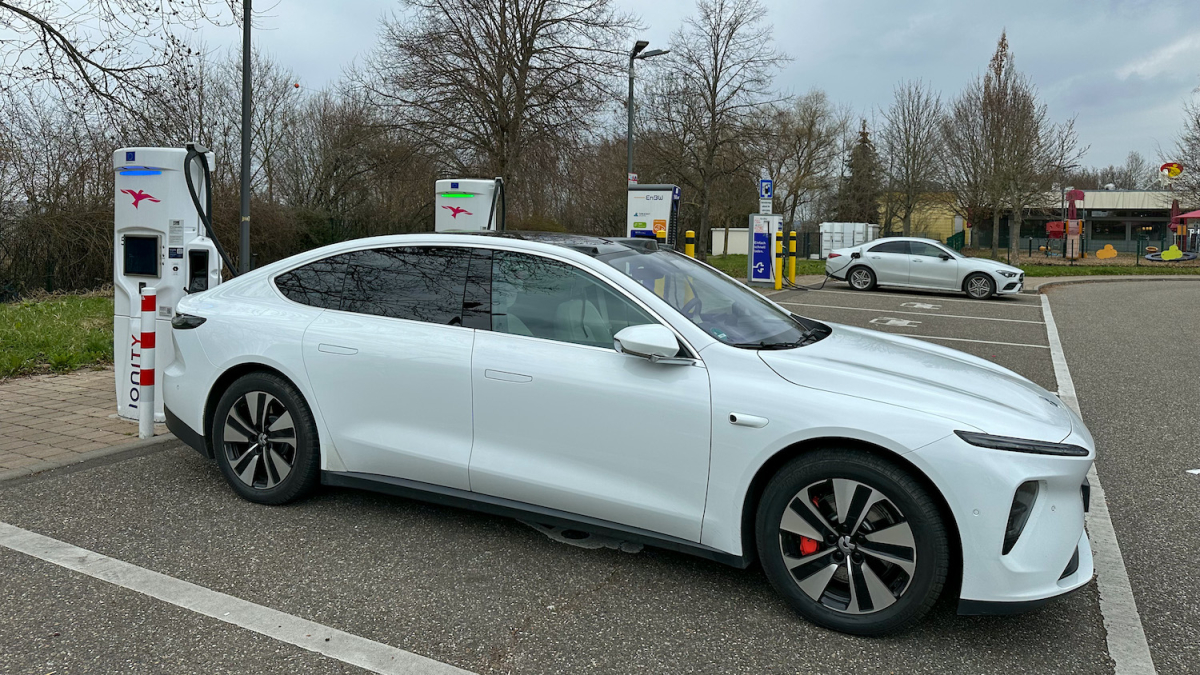All-electric luxury sedan with room for improvement
The Chinese startup Nio is undoubtedly one of the most interesting and innovative electric car manufacturers on the market at the moment. The expectations for the first model that Nio is launching in Germany are correspondingly high: the ET7.
It is quite remarkable and at the same time reflects the self-confidence of the Chinese that a luxury sedan was chosen for the German debut of the brand, which at best costs almost 82,000 euros (75 kWh battery) and in the maximum configuration (100 kWh battery) even costs more than 94,000 euros. The statement is unmistakable: Nio is a premium brand and stands for luxury. You see yourself in a league with Mercedes-Benz, Audi, BMW and Tesla. There shouldn’t even be any doubt about that.
We looked at whether the ET7 succeeds in everyday life.
Contents
- 1 Nio ET7: Fully equipped to the roof
- 2 Nio ET7: battery swap and impressive performance, but too little charging power
- 3 Nio ET7: Many software features, less intuitive UI
- 4 Nio ET7: High efficiency, expandable assistance systems
- 5 Nio ET7: promising premium electric car with a lot of untapped potential
Nio ET7: Fully equipped to the roof
While traditional car manufacturers usually lure their customers into the configurator with low base prices, so that tears come when you look at the optional extras, Nio takes a different approach. The ET7 has a comparatively high starting price, but the sedan comes with full equipment as standard – and full equipment here actually means full equipment.
The 5.1 meter long and almost two meter wide luxury electric car has every feature you can imagine: an air suspension that automatically adjusts the suspension to the road conditions, 33 sensor units (including lidar) for autonomous driving with a data throughput of eight Gigabits per second, 23 speakers with 1,000 watts of output power and Dolby Atmos, 12.8-inch Amoled center display, head-up display, air-conditioned massage seats at the rear and front, a gigantic panoramic roof, ambient lighting with 256 colors – and for you There are three (!) scents to choose from for scenting the interior.
In line with the zeitgeist, Nio uses sustainable materials for the interior, including the rattan-based non-wood material Karuun. In combination with the leatherette seat covers, this creates an extremely elegant interior.
The interior of the Nio ET7 is minimalist, but still looks classy and high quality. (Photo: Frank Feil)
The Nio ET7 is also impressive when it comes to electromobility: Thanks to the aerodynamically optimized body, the sedan achieves a drag coefficient of just 0.208. As a result, the ET7 with the 75 kilowatt hour battery has a range of 445 kilometers in the WLTP test cycle. If you opt for the 100 kilowatt hour battery, even 580 kilometers are possible.
But not only in terms of efficiency, but also in terms of performance, the Nio leaves no doubt that it is in the top league: the system output is 480 kilowatts (653 hp), the maximum torque is 850 Newton meters. This means that the 2.4-ton luxury electric car sprints from 0 to 100 km/h in 3.8 seconds. For comparison: A Mercedes-Benz EQE AMG 43 4Matic Plus, which costs almost 20,000 to 30,000 euros more with similar equipment, takes 4.2 seconds.
The charging capacity, on the other hand, does not really fit into the picture. A maximum of 130 kilowatts is possible, but in our test we often only got 100 kilowatts despite preconditioning. For a charging process from 10 to 80 percent SoC (state-of-charge), you have to schedule almost 40 minutes. That is simply too long for an electric car in this price segment in 2023.

Unfortunately, the Nio ET7 does not win a flower pot when it comes to charging performance. (Photo: Frank Feil)
To be fair, it must be mentioned at this point that the low charging capacity is mainly due to the fact that Nio focuses on its battery changing stations. This gives you a fully automatic battery within five minutes. Sounds good, but since there are only three of these battery swap stations in Germany so far, it doesn’t really help you in everyday life. After all: In the future, 20 EnBW fast charging parks in Germany are to be equipped with battery changing stations from Nio.
Important to know: The Nio ET7 can either be subscribed to or purchased. When buying, you have the choice of renting the battery for 169 euros (75 kWh) or 289 euros (100 kWh) per month or buying it for 12,000 euros or 21,000 euros. If you choose the latter, you cannot use the battery swap stations.
That’s the theory. time for practice.
As soon as you approach the Nio ET7, the handles extend and the doors with their frameless windows open a little by themselves. This is extremely convenient, especially since the doors can also be opened automatically with just one click when you get out.
The interior of the vehicle is characterized by the 12.8-inch Amoled center display and the 10.2-inch HDR instrument cluster. And then, of course, there would be Nomi, an AI-based language assistant that sits enthroned above the main display and constantly makes eyes at you while driving. Literally.
All in all, the ET7 is incredibly spacious. The interior is minimalist, but looks very classy. You immediately feel comfortable – and when Nio talks about a “second home”, that’s not so far from reality.


The Nio ET7 offers an incredible number of software features, but the UI design is somewhat unintuitive, which is why many functions are difficult to use, especially while driving. (Photo: Frank Feil)
There are hardly any physical buttons – and that takes some getting used to. Ultimately, the entire control of the ET7 runs via the Amoled center display. The problem is that the vehicle’s software is so extensive and offers so many functions that initially even seemingly simple things become a puzzle, such as switching on the heated seats. Some of the menus have several levels, and it takes quite a while to find your way around them. Intuitive is different.
Once you understand the operating logic, however, the possibilities are limitless: for example, there is a pet mode and a camping mode, both of which you would look for in vain even in a Mercedes-Benz EQS for 150,000 euros. Or a button that the owners of a Porsche Taycan would pay a lot of money for: “Warm up the battery”. Even the steering wheel and seat heating can be intelligently controlled if required.
We were amazed by the efficiency of the Nio ET7. Although the vehicle is huge, our consumption was between 19 and 21 kilowatt hours per 100 kilometers, depending on driving style and route profile, despite partly wintry temperatures. Ranges of around 500 kilometers are therefore quite realistic.
In terms of driving experience, the all-electric sedan is a comfortable long-distance glider. The air suspension absorbs almost all bumps, so that even after 700 kilometers on the motorway you arrive relaxed at your destination. However, the ET7 does not become a sports car even in Sport Plus mode. While it’s impressive when 2.4 tons accelerate from 0 to 100 km/h in 3.8 seconds, the weight is immediately noticeable as soon as corners come into play. The performance that can be called up in sport mode (0 to 100 km/h in 5.9 seconds) would have been completely sufficient in this vehicle category. Of course, it does not fit the Chinese self-image that their top model would not have been on par with Tesla.
Meanwhile, we were disappointed with the assistance systems: “Nio Aquila Super Sensing has 33 powerful sensor units. These include an ultra-long-range, high-resolution lidar, seven 8-MP high-resolution cameras, four 3-MP light-sensitive cameras, an enhanced driver monitoring system, five millimeter-wave radars, twelve ultrasonic sensors, redundant high-precision localization units, and HOD. It sets new standards for sensor systems in autonomous driving” – this is how Nio aggressively advertises the ET7. There is even a dedicated microsite dedicated to just how incredibly powerful the car is.

If you consider that the Nio ET7 is 5.1 meters long and two meters wide, the 370 liter trunk is downright modest. (Photo: Frank Feil)
We were all the more surprised that the assistance systems work rather mediocre in practice. Again and again there are warning messages for no reason or the system intervenes in the lane guidance – and not exactly gently. It may be difficult to convey to potential buyers that the assistance systems in the ET7 sometimes work worse than in four-year-old vehicles with far fewer cameras and sensors. It remains to be hoped that Nio will quickly improve this with an OTA update.
It is currently still difficult to draw a final conclusion about the Nio ET7.
On the one hand, the all-electric luxury sedan offers an unbelievable amount of performance, comfort and technology. The software offers all sorts of features that you won’t find in most of the competition – and with a range of around 500 kilometers and a consumption of almost 20 kilowatt hours per 100 kilometers, the ET7 is also extremely efficient. The battery-swap stations are definitely a remarkable unique selling point.
On the other hand, software with so many functions needs a well thought-out UI design – and the ET7 lacks that. The poor charging performance should also be a drawback, especially for those who travel a lot over long distances. Because it will be some time before there are battery swap stations throughout Germany. That leaves the assistance systems, which currently look more like a beta version than a finished product – at least if you consider how much energy Nio is putting into marketing autonomous driving.
However, these are all things that Nio should fix in a series of software updates in the near future. If that succeeds, you really get a lot of car for the money with the ET7.
All in all, the comparatively young Chinese e-car startup is already doing a lot right – and could become a real rival for German premium car manufacturers in the medium term. But before that, the Chinese have to do a little homework.
Electric cars – 5 prejudices and what is wrong with them:

These are Toyota’s new 15 models



